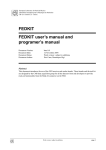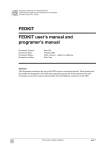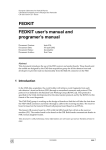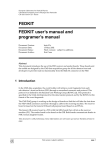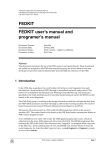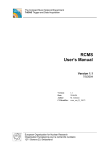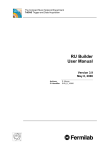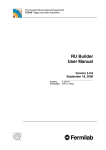Download I O core and Xdaq-shell frameworks
Transcript
I2O core and Xdaq-shell frameworks
E. Cano
CERN, Geneva, Switzerland
Abstract
This document describes the goal, architecture, and uses of the xdaq-shell (a user
space-kernel space generic communication scheme) and the i2o-core (a generic API
for hardware drivers development).
1 Introduction
FT
Keywords: I2O, Hardware, bus, PCI, library, API, kernel space, user space, Linux,
VxWorks, DMA, VME
In the current CMS data acquisition (DAQ) prototyping work, hardware prototypes have to
get integrated in software frameworks (slow control, fast control, high level triggers, etc.),
and the hardware abstraction layer of various Operating Systems (OS) is not well
standardized. As those pieces of hardware get tested and used in various environment, it is
quite convenient to define an environment that would allow the user to use the same
software in various those various environments.
RA
Architecture
I2O core is based on a portion of the I2O specification. The I2O specification is defined by
the I2O special interest group.
The I2O core is a hardware abstraction layer that allows to write low-level pieces of software
in a standardized fashion. The I2O core notably handles all bus-related actions, including
placing a transaction on the bus, detecting adapters and handling adapter allocation,
interrupt handling. It also adds support for common tasks in device driver, like event
queues, threads and semaphores.
The Xdaq-shell is a communication layer designed for communicating between user space
and kernel space. This layer is required for enabling communication between high level
applications (slow control applications, run control applications) and low level pieces of
software (controls for specific boards). This layer wouldn’t be necessary using an real time
operating system like VxWorks, so its implementation will be quite different depending on
which platform it is used on. However, the API for using the Xdaq-shell from both side
(I2O-core side and application side) is the same in all cases. See Figure 1 for an example in
the context of an Xdaq (software-only DAQ) application.
D
1.1
This kernel space-user space communication is required because one wants to have
communication between drivers (i2o core parts, that drives hardware) and high level
(networked, etc...) applications.
The Xdaq-shell and I2O core layer are seen from the user point of view as three separate
APIs. I2O core itself is the first API. This API defines prototypes of functions accessing the
low level (hardware).
1/18 I2Ocore-Xdaq-shell draft documentation last updated on 5 October 2001 12:13 pm
Xdaq-shell allows access to the “driver” (here meaning a set of kernel-level functions) from
the user space,and the opposite (access from kernel space to user space). This implies one
API for the kernel side and one API for the user side. In order to optimise the performance,
it is better to avoid contexts switches as much as possible. Therefore, the Xdaq-shell is based
on message passing schemes (all the parameters of an action are passed to the driver/sent
back to the user at once). Those two API will contain message passing functions (send and
receive), functions for allocating message, and function for resolving addresses. The
Xdaq-shell takes care of the routing of the messages.
In order to be able to access DMAable memory from user-space program, the Xdaq-shell
provides support for DMAable buffers (Dbuffs). The also provides support for direct
mapping of the PCI memory space in user space. All those advanced features are not
needed inbasic designs but can help to increase the performance when this is required.
FT
The various schemes that can be used to increase performance (especially in Linux systems
where the use of system calls costs non negleglectable time will be in Appendix C:
Performance critical designs).
User space (applications, paged memory)
RA
Xdaq-shell messaging Xdaq-shell Dbuffs
Message passing (copies)
Xdaq-shell PCIMaps
Mapping (no copy)
Mapping (no copy)
Interrupts
PCI device
DMA
Interrupts
Slave
accesses
D
Slave
accesses
Reserved
memory
for DMA
(physmem)
DMA engine
I2O core API
Address translation
I2O core
user’s
module
Xdaq-shell Dbuffs
Generic R/W module
Kernel space
Xdaq-shell messages
Figure 1: Kernel and user space layout in I2O core and Xdaq-shell applications. The red parts are
not yet implemented
1.2
Supported platforms and buses
For now the first prototypes are intended to be delivered for Linux and VxWorks. The target
bus for the first version will be the PCI bus. Following version might support other buses as
needs arise.
2/18 I2Ocore-Xdaq-shell draft documentation last updated on 5 October 2001 12:13 pm
2 I2O-core
As stated above, the goal of the I2O core is to provide low level access to the different
adapters present in a system. In the first versions, it is limited to the PCI devices. It is
possible to include extensions to VME bus in the future.
2.1
Original specification
2.2
FT
The original specification defined an Intelligent Realtime OS (IRTOS). The API to the system
calls of this system are called I2O-core. Our work is based on the I2O-core definition from
Intelligent I/O Architecture Specification Version 2.0 [1]. This implementation is mainly
based on chapter 5 of this document, and more precisely on sub-chapter 5.4 : IRTOS: I2O
Real-Time OS. The specification defines various concepts of Device Driver Modules,
Executive, Code loading, etc. that we won’t be using here. The only part of the specification
used in this development is the API to low level functions.
CMS-DAQ implementation and adaptation
The CMS-DAQ version of I2O core contains the following parts of the SIG version:
• Event queues (as defined in [1] 5.4.2.4)
• Threads (as defined in [1] 5.4.18)
• Buses (as defined in [1] 5.4.11)
RA
• Adapters(as defined in [1] 5.4.12)
• Interrupts(as defined in [1] 5.4.14)
• Semaphores (as defined in [1] 5.4.20)
• Busy wait (as defined in [1] 5.4.19)
Object ID and object handling
The I2O core handles all objects in a standard way, much like in an object-oriented system.
All objects inherit from the base object. In order to simulate this the structures contain
pointers to their respective “member” functions in a generic header. The user doesn’t have
to handle this part, normally. All object is owned by another object. When the owner object
is destroyed, all the owned objects are destroyed as well automatically. The user can also
destroy an object explicitly by using the i2oObjDestroy function. All the functions in the
i2oObj* series work on all object IDs.
D
2.2.1
The user can also bypass the owner handling by using a NULL owner ID, but in this case,
he has to handle all the destructions by hand. (Instead, he can create a first object with owner
ID zero (ususally the adapter), and then make it owner of all the other ones. Then, calling
i2oObjDestroy on the first one will automatically destroy all the owned objects.
We can add here that the i2oExecutive* functions return object with no owner. This
object (the adapter) and be used as the owner of all your other objects. Therefore all the
object can be destroyed in one operation by releasing the adapter. This avoids the tracking
of too many object IDs.
3/18 I2Ocore-Xdaq-shell draft documentation last updated on 5 October 2001 12:13 pm
2.2.2
Internal implementation
Depending on the system on which we run, we have C++ support or not. The easiest version
is with VxWorks, as the IRTOS API defined by the I2O SIG matches the VxWorks API very
closely, and VxWorks supports C++, so we can implement the object concepts of I2O core
directly in C++.
Under Linux, we have to use tricks in order to implement the object likeliness. This is done
through a private head that is common to all structure. The head is a struct containing
pointers to all the functions handling that special object, in a fashion close to the one used
in virtual tables. The user doesn’t have to worry about those internal details, which are
handled through the i2oObj* functions.
FT
Internally, each object type has to have a specific destructor function with a skeleton
identical to this one :
void i2oSemDestroy (I2O_OBJ_ID objectID, I2O_STATUS * pStatus)
{
I2O_SEM_ID semID = (I2O_SEM_ID) objectID;
while (down_trylock(&semID->sem))
up (&semID->sem);
i2oObjDefaultDestroy (objectID, pStatus);
}
Note that only specific action is required, then one just need to call
i2oObjDefaultDestroy (objectID, pStatus);
RA
The default destroy function handles everything linked to the common headers in all
objects, including destroying owned objects.
A user who doesn’t want to change or extend the dehaviour of objects in I2O core needs not
to take care of the internal implementation.
API
The API to the various components of the I2O core match as much as possible the API
defined in the standard header files provided by the I2O SIG. The implementation matches
well the API for event queues, threads, buses, interrupts and semaphores. However, a
shortcut had to be developped to replace adapter allocation system from the standard I2O
(involving message passing between Device Driver Modules and IRTOS’s executive) by two
simple function calls. This shortcut removes a whole lot of overhead that involved message
passing and a quite heavy protocol during the loading of the device driver module, a
concept of I2O that we don’t use here. The resulting API is described thereafter. If anything
is unclear in this definition, the user should use the standard I2O Architecture Specification
version 2.0 and the C header files for this version.
D
2.3
A simple axample of use of the I2O-core can be found in Appendix B: Basic design with
i2o-core and Xdaq-shell. All the functions defined in this implementation is I2O core are
listed in Appendix A : Functions summary.
All the functions in the I2O-core specification accept as their last argument a pointer to an
I2O_STATUS variable. If the pointer is non-NULL, the i2o function should only report the
error in this variable. The i2o function doesn’t set it to I2O_STS_OK in case of success, so
that the programmer can call several i2o functions in a row, and check for successful
4/18 I2Ocore-Xdaq-shell draft documentation last updated on 5 October 2001 12:13 pm
completion only at the end. The progammer can also pass I2O_NO_STATUS as the pointer.
This informs the i2o function that he won’t check for an error and that it’s up to the i2o
function to handle the error. This mecanism is explained extensively in I2O specification, in
paragraph 5.4.2.1.2 .
2.3.1
Generic Objects
The following functions are available for each object IDs (and i2oObj* operation can be
applied to any ID (I2O_ADAPTER_ID, I2O_BUS_ID, etc...). Any ID can also be used as an
I2O_OBJECT_ID (by casting it). For example, if the user wants to destroy any object, he just
has to call i2oObjDestroy ((I2O_OBJECT_ID) myObjectId).
FT
In the I2O core, all object have an owner (the owner can also be NULL). Owner is usually
set at creation time. It can be modified at anytime using the function i2oObjOwnerSet. Like
i2oObjDestyroy, this function works on all the object types through a cast.
The user should be aware that by destroying an object, he also destroys all the objects owned
by this one. (Ownership relations create a tree organisation).
2.3.2
Adapter
RA
In the I2O-core semantics, and adapter is a device on a bus. From now on, an adapter is a
PCI board, but this concept might be extended to VME boards. In a program using I2O-core,
the first action is usually to allocate an adapter and get the first reference to it. Those
routines are the main shortcut added to the specification.
I2O_ADAPTER_ID i2oExecutivePciAdapterAttach(U16 PciVendorID, U16 PciDeviceID,
int index, I2O_STATUS* pStatus);
void i2oExecutiveAdapterDetach (I2O_ADAPTER_ID id);
Those two functions allow the driver to allocate an adapter(and therefore access the
function attached to it), and to release the adapter. In the case of extension of this to VME
bus, some functions would be added here in the API, to allow configuration of VME boards
in the executive (VME boards are not auto detected like PCI boards).
The adapter object also allows accesses to configuration functions:
D
i2oAdapterBusGet
i2oConfig{Read|Write}{8|16|32|64}
i2oAdapterIntLock
i2oAdapterIntUnlock
i2oAdapterPhysLocGet
See paragraph 5.4.12 for functions details.
2.3.3
Interrrupt
Interrupts are available through the adapter object. One just has to attach an interrupt
service routine handler to the adapter. The function are defined in paragraph 5.4.14 of I2O
specification.
2.3.4
Bus
The accesses to buses are defined in paragraph 5.4.11 of the I2O specification. The API of our
implementation contains the following functions :
5/18 I2Ocore-Xdaq-shell draft documentation last updated on 5 October 2001 12:13 pm
i2oBusLocal
i2oBusSystem
i2oBus{Read|Write}{8|16|32|64}
i2oBusTranslate
The two first functions return an ID of the local bus and of the system bus.
The “translate” function allows tranlation of addresses on one bus as seen from another one,
in order to allow simple programming of DMAs.
2.3.5
Thread
The I2O-core library allows the user to spawn threads in its driver, but usually, the thread
spawned automatically by the event queue is enough to handle the requests comming from
the user, or to handle large parts of processing required after an interrupt.
i2oThreadCreate
i2oThreadDelay
i2oThreadIdSelf
i2oThreadLock
i2oThreadUnlock
i2oThreadPri{Get|Set}
FT
The API is the following (some of the functions defined in I2O specification are not
implemented yet):
The corresponding paragraph in the specification is paragraph 5.4.18.
Event Queue (EventQ)
RA
2.3.6
Event queue is just a process waiting on a FIFO, and looping indefinitely waiting for events
to come.
It is quite important, because this loop is usually the heart of the driver, waiting for user
interaction (possibly through Xdaq-shell). Typically, the interrupt service routine will
handle the low level things in order to get the interrupt cleared and then post the remaining
of the work to the driver’s event queue. Alternativally, it can also post a reply directly to an
Xdaq-shell file.
It is defined in the I2O specification in paragraph 5.4.2.4.
The functions are the following:
D
i2oEventQCreate
i2oEventQThreadGet
i2oEventQPost
The functions defining priorities of events in queues are not implemented in the present
version. The event queue has a FIFO behavior.
2.3.7
Semaphore
Semaphores are also available. The are defined in specification paragraph 5.4.20. There are
three types of semaphores: binary semaphores, ounting semaphores and mutual exclusion
(mutex) semaphores.
The functions in the API are :
6/18 I2Ocore-Xdaq-shell draft documentation last updated on 5 October 2001 12:13 pm
i2oSem{B|C|M}Create
i2oSemTake
i2oSemGive
The timeout functionnality is not available on Linux for now. Only immediate return and
infinite wait are available for the moment.
2.4
Performance impact
Performance impact of the usage of I2O-core compared with native drivers (direct calls to
OS functions) will be studied once the I2O-core will be ready on each platform.
3.1
Architecture
FT
3 Xdaq-shell
RA
The Xdaq-shell is defined to be a communication layer between user space and kernel
space, when this distinction applies. Performance has to be as good as possible. To minimise
overhead of kernel-user and user-kernel context switches, it is better to use a message
passing scheme. The message structure in the Xdaq-shell is composed of two parts. First
part is the routing layer, and is handled by Xdaq-shell. It is just a fixed-size header added
to the messages. The structure of the messages is architecture dependant, so the user should
not rely on the internal layout of the i2o_msg structure. The other part is totally defined by
the user, usually also as a structure.
The current implementation is based on fixed-size FIFOs. This could lead to messages loss
if some FIFOs become full.
3.2
API
All functions and structures defined in the Xdaq-shell start with “xdsh”.
3.2.1
Module strucuture
D
Each object file created by the user has to register a service to the Xdaq-shell, and to
unregister when the module is unloaded. This is done thanks to two special functions :
xdsh_init and xdsh_cleanup. Thos two functions, created by the user, typically contain the
registration of the callback functions. See the example in Section 3.3, "Example programs".
Also see Section 4, "User’s manual" for details specific to each plateform (compilation
options, etc.).
3.2.2
Message structure
The messages transported by the Xdaq-shell are very simple and contain two parts. First
part is a fixed size header, which is architecture dependant, and second part is completely
up to the user. This second part, the payload, can be accessed through a function call.
7/18 I2Ocore-Xdaq-shell draft documentation last updated on 5 October 2001 12:13 pm
3.2.3
Message allocation and handling functions
The messages are allocated and deallocated by using special function calls. This allows the
Xdaq-shell to handle messages differently according to the system it is used on. Therefore,
the user has to consider a message as deallocated as soon as it has been sent, and the library
automatically allocates the message frame of the right size when the user receives the
message. On the other hand, it’s up to the user to deallocate a message he received through
a “get_message” function. This scheme allows us to pass pointers directly on systems with
no memory protection (namely, VxWorks).
The message structures are allocated and de-allocated as folows :
struct xdsh_msg * xdsh_alloc (u32 size);
void xdsh_free (struct xdsh_msg *);
FT
and by all the message passing functions.
Those functions work as usual, and xdsh_alloc returns NULL in case of failure during
allocation.
The user should only be interested in the size of the payload and in the payload itself. The
payload would typically contain a structure defined by the user. Functions for accessing the
payload are:
void * xdsh_msg_payload (struct xdsh_msg *);
u32 xdsh_msg_size (const struct xdsh_msg *);
RA
Parameter size is the size of the payload in bytes. The maximum theoretical size of a
message is therefore 4 Gigabytes, which if far above what the computer system can allow in
pratice.
A typical use of this scheme is shown on Figure 2. This kind of use is valid in both user space
and kernel space.
D
struct xdsh_msg *message = xdsh_alloc (sizeof (struct device_specific));
struct device_specific *payload =
(struct device_specific *) xdsh_msg_payload (message);
device_specific_init (payload);
payload->field1 = some_value;
payload->field2 = yet_another_value;
Figure 2: Code example: Message allocation and payload access in Xdaq-shell
TODO : evaluation of the practical maximum sizes of messages in different situations.
3.2.4
Address resolution functions
When the user wants to access the driver functions (send command/receive replies), he
should identify itself to the Xdaq-shell. This corresponds to opening a file descriptor to the
driver. This creates and “access point” through which message are send, and more
important replies are sent back. A program can creat many of those. A reply to a command
will always come back to the same xdsh_file. The function used for that is:
8/18 I2Ocore-Xdaq-shell draft documentation last updated on 5 October 2001 12:13 pm
struct xdsh_file * fd = xdsh_open ();
void xdsh_close (struct xdsh_file * fd);
The open function may return NULL on failure.
When the user wants to access a function, he should first get the address for this function,
this is done through the xdsh_file structure:
xdsh_srvc_addr xdsh_get_address (struct xdsh_file * file,
const char *service_name);
FT
The service name is a string defined by the user, and registered by the driver program. The
driver program has to provide a callback function that handles the message (either directly
or by posting it to a queue), but this part is handled typically by I2O-core applications. This
function returns NULL_address if the service was not found. To compare xdsh_srvc_addr
variables, the user has to use a special function (as the bytewise comparison trivial
operator== is only defined by the c++ compiler (alas)). the special function for
xdsh_srvc_addr comparison is :
int xdsh_service_cmp (xdsh_srvc_addr a, xdsh_srvc_addr b);
This one returns non-zero if the two addresses are equal.
typedef int (*xdsh_callback) (struct xdsh_msg *);
int xdsh_register_service (xdsh_callbak service_callback,
const char * service_name);
void xdsh_unregister_service (const char * service_name);
RA
Those functions return non-zero if something fails (for example if the service is already
registered).
TODO : define return values for xdsh_callbacks and xdsh_register_service.
Message passing functions
Once the address is resolved for the service, the user function can access the driver, by
calling message passing functions.
int xdsh_send_message (struct xdsh_file *fd,
xdsh_srvc_addr service_address,
struct xdsh_msg * message);
This function call will return the result of:
service_callback(message);
D
3.2.5
To get replies to the commands sent to services through a given file descriptor, the user
program just has to use the reply function on the same file descriptor. The get reply function
exists in two flavors: blocking and non blocking. There is no timeout method available for
the moment.
struct xdsh_msg * xdsh_get_reply (struct xdsh_file *fd);
struct xdsh_msg * xdsh_get_reply_non_block (struct xdsh_file * fd);
Both function return NULL on failure. When the non-blocking function returns NULL, there
is non reply message waiting in the queue. The blocking function can return NULL in some
cases (like if the file descriptor is closed by another thread).
On the other side (kernel side) the functions are as follows:
9/18 I2Ocore-Xdaq-shell draft documentation last updated on 5 October 2001 12:13 pm
struct xdsh_sender xdsh_get_sender (struct xdsh_msg * message);
int xdsh_send_reply (xdsh_sender * sender, struct xdsh_msg *reply);
As usual, xdsh_send_reply returns non-zero on failure.
TODO : define error codes.
It’s up to the function that got the message (through “get_reply” or a callback) to dispose of
the message frame. This can be done through a free, or the message frame can be reused for
the reply.
3.2.6
Buffer allocation functions
FT
In order to be able to transfer efficiently important amounts of data between hardware cards
and programs, we need to use DMA-able buffers. Thoses buffers are typically allocated at
the beginning of the application run and freed when the application finished. As these
DMAable buffers have to be acessed through different adresses depending on the space we
work on, it is handled through a structure that is common to user and kernel space (i.e. it
can be passed as a member of a user message payload.
The buffer has to be accessed through various functions. The functions usable in user side
are:
struct xdsh_Dbuff * xdsh_Dbuff_allocate (xdsh_file * fd, u32 size);
void * xdsh_Dbuff_user_address (struct xdsh_Dbuff * dma_buffer);
void xdsh_Dbuff_free (xdsh_file * fd, struct xdsh_Dbuff *);
RA
Once again xdsh_Dbuff_allocate returns NULL on failure.
The functions usable on the kernel side are:
void * xdsh_Dbuff_kernel_address (struct xdsh_Dbuff * dma_buffer);
u32 xdsh_Dbuff_physical_address (struct xdsh_Dbuff * dma_buffer);
PCI device mapping
For the high perfoemance needs, there is the possibility to map the PCI bus in user space. In
thie configuration, the user loses the layering of the system. There is not anymore a kernel
space driver, and just communications between user and kernel space through Xdaq-shell.
Instead, the kernel space driver needs to allocate the board, get its base address, possibly
perform some initialisation, register the interrupt and then leave it up to user space
programs to control the board in normal operation.
The API to the PCI maps is the following :
D
3.2.7
struct xdsh_Pmap * xdsh_Pmap_create (u32 base_address, u32 range);
u32 * xdsh_Pmap_user_address (struct xdsh_Pmap * pmap);
void xdsh_Pmap_destroy (struct xdsh_Pmap * pmap);
As usual, xdsh_Pmap_create returns NULL in case of failure.
Once the PCI is mapped in user space, reading a pointer in the mapped address is as fast as
reading from memory, an involves no call to the system.
10/18 I2Ocore-Xdaq-shell draft documentation last updated on 5 October 2001 12:13 pm
3.2.8
Miscelaneous utility functions
• Debug statements
Xdaq-shell also provides utilty functions for printing messages (on the standard
output or standard error for the user program, on the syslog for the kernel part).
Those functions are iprintf, eprintf, idprintf and edprintf (i standing for infomation, e
standing for error, and d for debug). The “*d*” functions only work if the
preprocessor macro DEBUG is defined at compile time (trough the -DDEBUG
command line option by example).
int {e,i}[d]printf (const char * format, ...);
• Pre-installed module for basic PCI access
3.2.9
Header files
FT
The Xdaq-shell kernel side comes by default with a TrivialPCI module, which maps
all the accesses on the PCI bus to correponding accesses in user space. This is usefull
for debuging of hardware, of first quick and dirty tests of sofware. This is not
performance oriented, but can be usefull for debuging. A corresponding userspace
library will be provided but is still TBD. TODO.
The Xdaq-shell just requires inclusion of the xdaq-shell.h header file.
Example programs
RA
3.3
Here we present a simple program that makes a board do a DMA into a buffer. The user
application then receives a message announcing the DMA completion.
First let’s see the structures used in this program: we need a user payload for messages, and
we have to define some commands.
enum message_type {
fill_buffer,
buffer_filled,
fill_failed
};
D
struct DMA_message {
struct xdsh_Dbuff DMA_buffer;
enum message_type message_type;
}
const char * dma_name = “DMA_fill”;
const int dma_size = 1024;
Figure 3: Structures used in Xdaq-shell example program
3.3.1
Driver side (I2O-core side)
On the driver side, we have to register the function that handles the message. The driver
side part of the example is shown on Figure 4.
11/18 I2Ocore-Xdaq-shell draft documentation last updated on 5 October 2001 12:13 pm
User side
void xdsh_init (void)
{
xdsh_register_service (dma_callback, dma_name);
}
void xdsh_cleanup (void)
{
xdsh_unregister_service (dma_name);
}
FT
int dma_callback (struct xdsh_msg * msg)
{
struct DMA_message *m =
(struct DMA_message *)xdsh_msg_payload (msg);
if (m->message_type == fill_buffer) {
do_dma (/*to*/xdsh_Dbuff_physical_address(m->DMA_buffer));
m->message_type = buffer_filled;
xdsh_send_reply (xdsh_get_sender(msg), msg);
} else {
/* unknown command */
return -1;
}
}
Figure 4: Example program for Xdaq-shell on server (kernel) side
RA
On the user side, we just want to get a DMAed buffer from the driver. This program is show
on Figure 5.
test_DMA (void)
{
/* This part is initialisation. It is not critical (in speed) */
struct xdsh_Dbuff * buff = xdsh_Dbuff_allocate (dma_size);
struct xdsh_file * f = xdsh_open();
xdsh_srvc_addr dma_addr = xdsh_get_address (f, dma_name);
struct xdsh_msg * msg = xdsh_alloc (sizeof (struct DMA_message));
struct DMA_message * m =
(struct DMA_message *)xdsh_msg_payload (msg);
/* This is the time critical part */
m->message_type = fill_buffer;
m->DMA_buffer = *buff;
xdsh_send_message (f, dma_addr, msg);
msg = xdsh_receive_relpy (f);
m = (struct DMA_message *)xdsh_msg_payload (msg);
if (m->message_type == buffer_filled) {
do_something_with_buffer
(xdsh_Dbuff_user_address(&m->DMA_buffer));
xdsh_buffer_free (fd, &m->DMA_buffer);
}
/* free up thinqs here */
D
3.3.2
}
Figure 5: Example program for Xdaq-shell on user space side
12/18 I2Ocore-Xdaq-shell draft documentation last updated on 5 October 2001 12:13 pm
3.4
Performance impact
Performance impact of the usage of Xdaq-shell compared with native drivers (or absence
of drivers) will be studied once the Xdaq-shell will be ready on each platform.
4 User’s manual
4.1
Getting the software
The software can be retried from the CMS CVS server as an anonymous cvs user. The
command sequence is :
cvs -d :pserver:[email protected]:/cvs_server/repositories/TriDAS login
FT
(password is, at time of writing 98passwd. It can be found on the page : http://cmsdoc/
cmsoo/projects/cvs_server.html )
cvs -d :pserver:[email protected]:/cvs_server/repositories/TriDAS \
co -P TriDAS/daq/itools
cvs -d :pserver:[email protected]:/cvs_server/repositories/TriDAS \
co -P -r V01_00_I2O TriDAS/Auxiliary/i2o
VxWorks version
RA
4.2
Change directory to ‘TriDAS/daq/itools/core/src/vxworks/mv2304’. Change the
Makefile so that the variable VXINCLUDEDIR (by default equal to ‘/cms_cluster/
tornado-2.0/ppc/target/h/’) points to the appropriate directory for your tornado
installation.
Then run gmake. This will create and all in one .exe file containing the test program, plus
all i2ocore. This still has to be upgraded.
4.3
Linux version
How to compile link and run under Linux
D
TODO
5 Status and plans
5.1
I2O-core
The support included in i2ocore is quite complete up to now. i2ocore supports now Linux
kernels 2.2 and 2.4, with the same sources, and VxWorks. The implementation is quite
stable, now.
13/18 I2Ocore-Xdaq-shell draft documentation last updated on 5 October 2001 12:13 pm
Xdaq-shell
The xdaq-shell implementation was also ported to kernel 2.4 of linux (still compatible with
2.2). The send-get-reply calls and the timeout get-replys aren’t fully tested. The PCImaps
and the default general access module is not yet written.
References
I2O Special interest group, Intellignent I/O (I2O) Architecture Specification see I2O SIG web
site: http://www.i2osig.org
RA
FT
1
D
5.2
14/18 I2Ocore-Xdaq-shell draft documentation last updated on 5 October 2001 12:13 pm
Appendix A : Functions summary
I2O core functions
I2O_ADAPTER_ID i2oExecutiveAdapterAttach (U16 PciVendorID,
U16 PciDeviceID, int index, I2O_STATUS* pStatus)
void i2oExecutiveAdapterDetach (I2O_ADAPTER_ID id)
i2oAdapterIntLock
i2oAdapterIntUnlock
i2oAdapterPhysLocGet
i2oConfig{Read|Write}{8|16|32|64}
adapterId, I2O_STATUS * pStatus)
FT
I2O_BUS_ID i2oAdapterBusGet (I2O_ADAPTER_ID
i2oBusLocal
i2oBusSystem
i2oBus{Read|Write}{8|16|32|64}
i2oBusTranslate
RA
I2O_THREAD_ID i2oThreadCreate (I2O_OWNER_ID ownerId, I2O_THREAD_PRI threadPri,
I2O_THREAD_OPTIONS threadOptions, I2O_SIZE threadStackSize,
I2O_THREAD_FUNC *threadInitFunc, I2O_ARG threadArg, I2O_STATUS * pStatus)
void i2oThreadDelay (I2O_USECS usecs, I2O_STATUS * pStatus)
I2O_THREAD_ID i2oThreadIdSelf (I2O_STATUS * pStatus)
void i2oThreadLock (I2O_STATUS * pStatus)
void i2oThreadUnlock (I2O_STATUS * pStatus)
I2O_THREAD_PRI i2oThreadPriGet (I2O_THREAD_ID threadId, I2O_STATUS * pStatus)
void i2oThreadPriSet (I2O_THREAD_ID threadId, I2O_THREAD_PRI threadPri,
I2O_STATUS * pStatus)
i2oEventQCreate
i2oEventQThreadGet
i2oEventQPost
I2O_SEM_ID i2oSemBCreate (I2O_OWNER_ID ownerId, I2O_SEM_OPTIONS
I2O_SEM_B_STATE initialState, I2O_STATUS * pStatus)
I2O_SEM_ID i2oSemCCreate (I2O_OWNER_ID ownerId, I2O_SEM_OPTIONS
I2O_COUNT initialCount, I2O_STATUS * pStatus)
I2O_SEM_ID i2oSemMCreate (I2O_OWNER_ID ownerId, I2O_SEM_OPTIONS
I2O_STATUS * pStatus)
void i2oSemTake (I2O_SEM_ID semId, I2O_USECS timeout, I2O_STATUS
void i2oSemGive (I2O_SEM_ID semId, I2O_STATUS * pStatus)
semOptions,
semOptions,
semOptions,
* pStatus)
D
I2O_INT_ID i2oIntCreate (I2O_OWNER_ID ownerId, I2O_OBJ_CONTEXT intContext,
I2O_ADAPTER_ID adapterId, I2O_ISR_HANDLER * isrHandler, I2O_ARG isrArg,
I2O_EVENT_QUEUE_ID evtQId, I2O_COUNT maxEvts, I2O_STATUS * pStatus)
void i2oIntEventPost (I2O_INT_ID intId, I2O_EVENT_PRI evtPri,
I2O_EVENT_HANDLER intEvtHandler, I2O_ARG intEvtArg, I2O_STATUS * pStatus)
BOOL i2oIntInIsr (void)
I2O_INT_LOCK_KEY i2oIntLock (void)
void i2oIntUnlock (I2O_INT_LOCK_KEY key)
with (user defined function):
void threadInitFunction (I2O_ARG threadArg)
BOOL intHandled = intHandler (I2O_OBJ_CONTEXT intContext, I2O_ARG isrArg)
void intEvtHandler (I2O_OBJ_CONTEXT intContext)
15/18 I2Ocore-Xdaq-shell draft documentation last updated on 5 October 2001 12:13 pm
Xdaq-shell function
Functions common to both sides :
Functions for kernel side :
Functions for user side :
D
RA
FT
struct xdsh_msg * xdsh_alloc (u32 size);
void xdsh_free (struct xdsh_msg *);
void * xdsh_msg_payload (struct xdsh_msg *);
u32 xdsh_msg_size (const struct xdsh_msg *);
struct xdsh_file * fd = xdsh_open ();
void xdsh_close (struct xdsh_file * fd);
xdsh_srvc_addr xdsh_get_address (struct xdsh_file * file,
const char *service_name);
int xdsh_service_cmp (xdsh_srvc_addr a, xdsh_srvc_addr b);
typedef int (*xdsh_callback) (struct xdsh_msg *);
int xdsh_register_service (xdsh_callbak service_callback,
const char * service_name);
void xdsh_unregister_service (const char * service_name);
int xdsh_send_message (struct xdsh_file *fd,
xdsh_srvc_addr service_address,
struct xdsh_msg * message);
struct xdsh_msg * xdsh_get_reply (struct xdsh_file *fd);
struct xdsh_msg * xdsh_get_reply_non_block (struct xdsh_file * fd);
struct xdsh_sender xdsh_get_sender (struct xdsh_msg * message);
int xdsh_send_reply (xdsh_sender * sender, struct xdsh_msg *reply);
struct xdsh_Dbuff * xdsh_Dbuff_allocate (xdsh_file * fd, u32 size);
void * xdsh_Dbuff_user_address (struct xdsh_Dbuff * dma_buffer);
void xdsh_Dbuff_free (xdsh_file * fd, struct xdsh_Dbuff *);
void * xdsh_Dbuff_kernel_address (struct xdsh_Dbuff * dma_buffer);
u32 xdsh_Dbuff_physical_address (struct xdsh_Dbuff * dma_buffer);
int {e,i}[d]printf (const char * format, ...);
16/18 I2Ocore-Xdaq-shell draft documentation last updated on 5 October 2001 12:13 pm
Appendix B: Basic design with i2o-core and Xdaq-shell
D
RA
FT
TODO
17/18 I2Ocore-Xdaq-shell draft documentation last updated on 5 October 2001 12:13 pm
Appendix C: Performance critical designs
D
RA
FT
TODO
18/18 I2Ocore-Xdaq-shell draft documentation last updated on 5 October 2001 12:13 pm



















